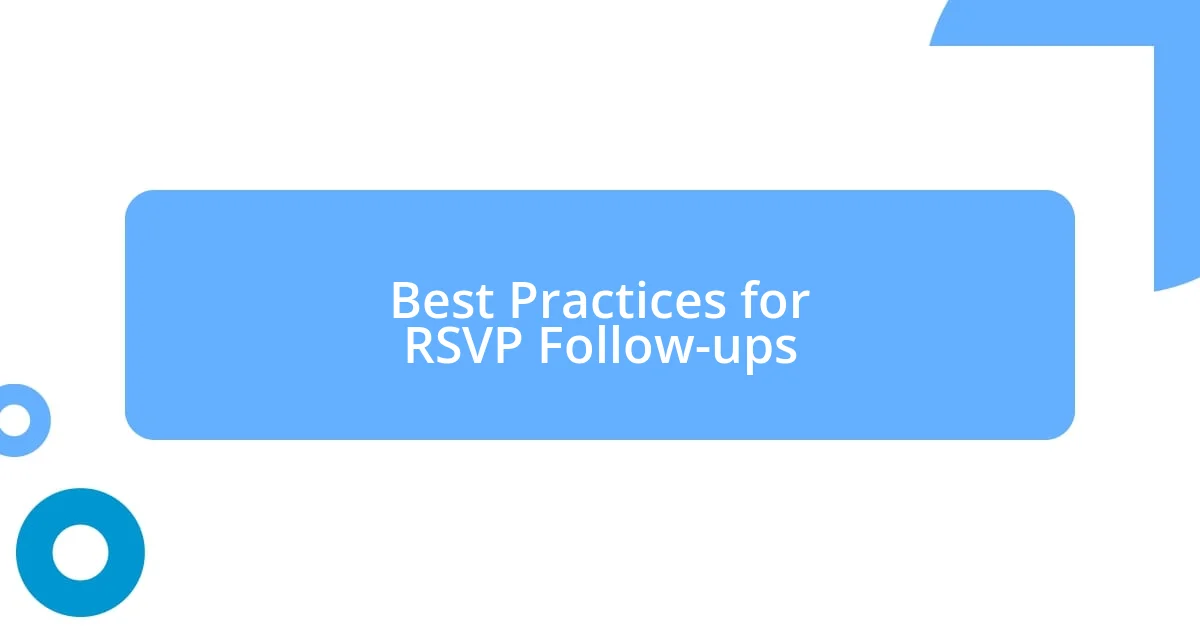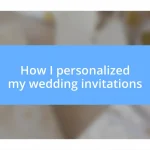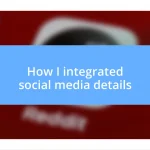Key takeaways:
- RSVP confirmation emails are vital for clear communication, enhancing guest experience, and building excitement about an event.
- Personalization, clear deadlines, and incentives can significantly increase response rates for RSVPs.
- Effective follow-ups, including gentle reminders and personalized outreach, improve response rates and connections with guests.

Understanding RSVP Confirmation Emails
RSVP confirmation emails serve as a crucial bridge between the host and attendees, establishing clear communication about event attendance. I remember planning a wedding and how the RSVP confirmations brought a sense of relief; finally seeing who would share in our special day made it feel more real. Have you ever felt uncertain about the number of guests at an event? Those confirmations help solidify plans and reduce anxiety.
These emails not only confirm attendance but also provide an opportunity for hosts to convey essential details, like dress codes or directions. When I received an RSVP confirmation for a friend’s milestone birthday, the thoughtful inclusion of venue specifics and timing made me feel valued as a guest. It’s intriguing to think—how often do we overlook the personal touch in these confirmations?
Moreover, confirmation emails can enhance the overall guest experience by building excitement and engagement. When I sent out invitations for a corporate retreat, the follow-up confirmation emails included a sneak peek of activities planned, which sparked anticipation among my colleagues. Isn’t it fascinating how a simple email can foster a connection and create enthusiasm for the event?

Importance of RSVP Confirmation Emails
RSVP confirmation emails are not just a formality; they play an essential role in setting the tone for the event. I recall organizing a community fundraiser and how each confirmation made me feel more connected to the attendees. As I received those emails, it was like building a virtual rapport, as if each response was a small step toward creating a shared experience. This emotional connection reinforces the idea that every guest’s presence is valued and anticipated.
- They create a clear line of communication, reducing uncertainty for both hosts and guests.
- They allow hosts to share important details, enhancing the guest experience.
- They can generate excitement and anticipation, transforming the event into something to look forward to.
I’ve learned that these emails also help in managing logistics effectively. When planning a family reunion, I relied heavily on the RSVP confirmations to estimate food quantities and seating arrangements. It was deeply rewarding to see those confirmations come in; it felt like gathering pieces of a puzzle, ensuring everyone would fit perfectly into our plans. Have you experienced that satisfaction in knowing everything is falling into place?

Strategies to Increase Response Rates
While crafting RSVP confirmation emails, one effective strategy to increase response rates is to personalize the content. I often find that addressing guests by name adds a touch of warmth and encourages them to engage with the email. For example, when I planned a family gathering, I tailored each confirmation email with personal notes like, “I can’t wait to catch up with you, Aunt Sarah!” This small detail made a significant difference in how quickly responses poured in.
Another strategy that I’ve seen work wonders is to set a clear deadline for replies. I remember organizing a book club meeting where I asked for RSVPs by a specific date. This urgency created a sense of commitment among the members; it’s like providing a gentle nudge that reassures them their presence is desired. When you’re clear about timelines, it helps people prioritize their responses amidst their busy schedules.
Finally, including incentives can boost engagement. During a friend’s bridal shower, I included a note in my RSVP confirmation email that mentioned a fun raffle for those who confirmed early. It sparked excitement and resulted in an impressive RSVP rate! Incentives can transform a simple email into something people are motivated to respond to.
| Strategy | Description |
|---|---|
| Personalization | Including guest names and personal notes to foster connection. |
| Clear Deadlines | Encouraging timely responses by specifying a deadline. |
| Incentives | Offering rewards for early confirmations to increase engagement. |

Common Mistakes to Avoid
One common mistake I see is neglecting to follow up with guests who haven’t responded. I’ve experienced this firsthand when planning an outdoor picnic. I waited too long to check in with those who didn’t reply, and it resulted in an uncomfortable scramble for food and seating when the day came. Imagine the peace of mind you could have by proactively reaching out—what if a simple reminder could spark that much-needed response?
Another noteworthy misstep is sending an RSVP confirmation email that lacks essential details. I remember receiving an invitation to a wedding, where crucial information like dress code and location was missing. I felt left in the dark, and I can assure you, that uncertainty outweighs any excitement you might want to evoke. It’s vital to ensure that your email serves as a comprehensive guide, leaving guests feeling informed and eager to attend.
Lastly, I can’t stress enough the importance of timing. I once sent an RSVP email far too close to the event date, which led to confusion and fewer confirmations. Think about it—when you’re juggling multiple commitments, who has time to respond at the last minute? Providing ample time allows guests to reflect on their plans, making them more likely to prioritize your event.

Analyzing RSVP Email Performance
Analyzing the performance of your RSVP email is crucial to understanding what works and what doesn’t. In my experience, tracking open rates and response times can reveal whether your subject line grabs attention or if your messaging resonates. For instance, I once tested two different subject lines for a gathering—a sentimental phrase versus a straightforward “Please RSVP.” The sentimental approach not only had a higher open rate but also led to quicker replies.
Another aspect I’ve noticed is the correlation between email design and response rates. I once sent a plain text RSVP email for a reunion that didn’t excite anyone. But when I switched to a vibrant, visually appealing layout for another event, the engagement skyrocketed. It’s fascinating to think—doesn’t a well-designed email just feel more inviting?
Lastly, feedback from guests can be a goldmine for refining your approach. After a recent party, I asked attendees directly what influenced their decision to RSVP. Many mentioned clarity in the email and appealing visuals, which helped them commit. I realized then that understanding your audience’s preferences is absolutely key in crafting impactful RSVP emails. It’s this kind of direct insight that transforms how I approach future invitations.

Best Practices for RSVP Follow-ups
When it comes to following up on RSVPs, timing really is key. I’ve learned that gently nudging those who haven’t yet replied can make all the difference. For instance, after an initial email for a birthday party, I sent a soft reminder a week later. It felt less like pestering and more like checking in, and surprisingly, I got several confirmations that day. Isn’t it amazing how a simple follow-up can encourage someone to commit?
Another best practice is to personalize your follow-up emails. I vividly recall reaching out individually to a few close friends after a group invitation yielded fewer replies than expected. By adding a personal touch—like, “Hey, I’d love to celebrate with you!”—the response was much more favorable. People appreciate feeling valued and often respond more favorably when they sense a genuine connection. How much easier does it feel to RSVP when you see that the host truly cares?
Lastly, consider providing a revised plan in your follow-up, especially if deadlines are looming. I once hosted a barbecue that faced weather uncertainties, prompting me to reach out with a new time and location. In my email, I included contingency plans. This type of proactive communication not only eased my guests’ concerns but also made them feel informed and included. Isn’t it reassuring when organizers take the initiative to keep us in the loop?













